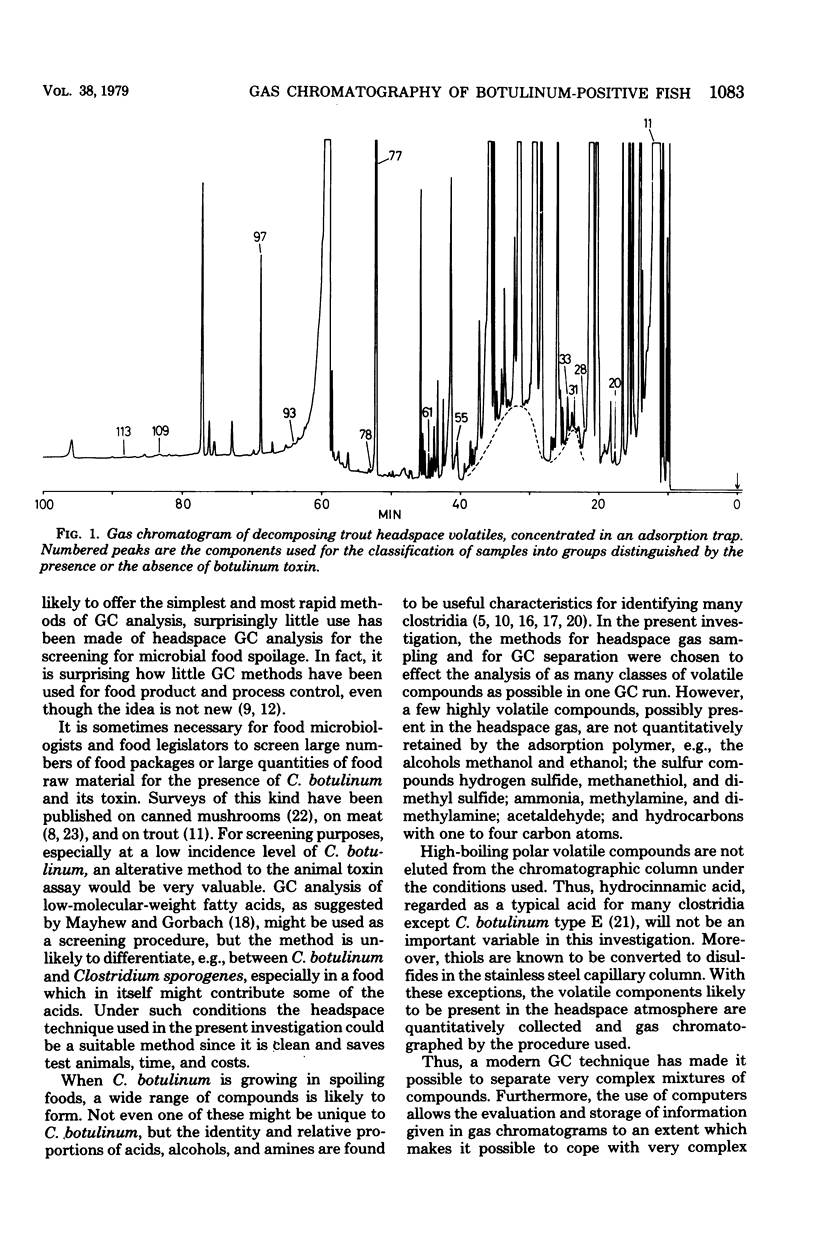Abstract
A gas chromatographic headspace technique was used to analyze the gas produced during putrefaction of pond-raised, degutted trout, incubated in evacuated plastic pouches. The following samples were analyzed; 10 samples which, due to natural contamination with Clostridium botulinum, were toxic when injected into mice, 10 samples which were nontoxic when injected, and 9 samples inoculated with one strain of C. botulinum type E. The gas chromatograms showed the presence of 118 compounds in most samples. Quantitative differences among most chromatograms could be observed, but no compound was unique to any of the three groups. By means of a specific pattern recognition method, all negative samples were shown to fall into one group and were distinctly separated from the toxic samples. No differences could be observed between the two groups of inoculated and naturally contaminated trout samples. The results suggest that headspace analysis combined with pattern recognition analysis might prove to be a valuable method for screening studies of foods containing living cells of C. botulinum.
Full text
PDF




Selected References
These references are in PubMed. This may not be the complete list of references from this article.
- Blomquist G., Johansson E., Söderström B., Wold S. Classification of fungi by means of pyrolysis-gas chromatography-pattern recognition. J Chromatogr. 1979 May 11;173(1):19–32. doi: 10.1016/s0021-9673(01)80442-8. [DOI] [PubMed] [Google Scholar]
- Blomquist G., Johansson E., Söderström B., Wold S. Reproducibility of pyrolysis-gas chromatographic analyses of the mould Penicillium brevi-compactum. J Chromatogr. 1979 May 11;173(1):7–17. doi: 10.1016/s0021-9673(01)80441-6. [DOI] [PubMed] [Google Scholar]
- Brooks J. B., Moore W. E. Gas chromatographic analysis of amines and other compounds produced by several species of Clostridium. Can J Microbiol. 1969 Dec;15(12):1433–1447. doi: 10.1139/m69-257. [DOI] [PubMed] [Google Scholar]
- Cone R. D., Lechowich R. V. Differentiation of Clostridium botulinum types A, B, and E by pyrolysis-gas-liquid chromatography. Appl Microbiol. 1970 Jan;19(1):138–145. doi: 10.1128/am.19.1.138-145.1970. [DOI] [PMC free article] [PubMed] [Google Scholar]
- Drasar B. S., Goddard P., Heaton S., Peach S., West B. Clostridia isolated from faeces. J Med Microbiol. 1976 Feb;9(1):63–71. doi: 10.1099/00222615-9-1-63. [DOI] [PubMed] [Google Scholar]
- Dunn W. J., 3rd, Wold S. A structure-carcinogenicity study of 4-nitroquinoline 1-oxides using the SIMCA method of pattern recognition. J Med Chem. 1978 Oct;21(10):1001–1007. doi: 10.1021/jm00208a001. [DOI] [PubMed] [Google Scholar]
- Larsson L., Märdh P. A., Odham G. Detection of alcohols and volatile fatty acids by head-space gas chromatography in identification of anaerobic bacteria. J Clin Microbiol. 1978 Jan;7(1):23–27. doi: 10.1128/jcm.7.1.23-27.1978. [DOI] [PMC free article] [PubMed] [Google Scholar]
- Larsson L., Mårdh P. A., Odham G. Analysis of amines and other bacterial products by head-space gas chromatography. Acta Pathol Microbiol Scand B. 1978 Aug;86(4):207–213. doi: 10.1111/j.1699-0463.1978.tb00033.x. [DOI] [PubMed] [Google Scholar]
- Mayhew J. W., Gorbach S. L. Rapid gas chromatographic technique for presumptive detection of Clostridium botulinum in contaminated food. Appl Microbiol. 1975 Feb;29(2):297–299. doi: 10.1128/am.29.2.297-299.1975. [DOI] [PMC free article] [PubMed] [Google Scholar]
- Moss C. W., Lambert M. A., Goldsmith D. J. Production of hydrocinnamic acid by clostridia. Appl Microbiol. 1970 Feb;19(2):375–378. doi: 10.1128/am.19.2.375-378.1970. [DOI] [PMC free article] [PubMed] [Google Scholar]


